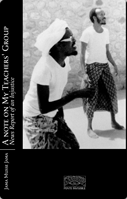|
Wisdom of the Day
|
| ...daily updates... | |
Qalinkaa wax suureeya,
Kugu sima halkaad doonto,
Saaxiib kal furan weeye,
Sunto fara ku hayntiisa,
Weligaa ha sii deynin.
"Sahra" - M I W Hadraawi suugaan |
|
|
 |
Rules of the Layli Game: English
These rules are also available in Italian and Somali
|
|
Rules of the Layli Game
A B C D E F
----[ 4]---[ 4]---[ 4]---[ 4]---[ 4]---[ 4]---
| |
----[ 4]---[ 4]---[ 4]---[ 4]---[ 4]---[ 4]---
G H I J K L
Each player owns the six holes on his side of the board.
A player picks up all the pebbles in one of his holes, and redistributes
them into the holes by moving counter-clockwise around the board, from
his own row to the opponent's and back again to his own. The player
deposits the pebbles, one at time, in each hole that the hand passes
over without skipping, until the pieces are used up.
If the last piece is dropped into a hole with pebbles, then the player
again picks up all the pieces in this hole and again restarts
redistributing them in the same manner.
A move ends when the last piece is dropped into an empty hole or a
pregnant hole. Only after a move finished, the player can capture
pebbles according to the following rules:
No capture is made if the last piece is dropped into a hole in the
adversary row.
No capture is made if the last piece is dropped into a pregnant hole.
No capture is made if the last piece is dropped into a hole of which
opposite hole is empty.
Otherwise (the hole in which the last piece is dropped is in the
player's row and it is not pregnant):
If the opposite hole contains one, two, four or more pebbles,
then all these pebbles and the last pebble to be sown are taken and
captured by the player. Both of the opposite holes, therefore, become
empty.
If the opposite hole contains three pebbles then one pebble is
transferred from this hole to the hole in which the last pebble in hand
was sown, making the contents of the both holes two pebbles. Each of
these two holes become an Uur (pregnant) which belongs to the player who
made them Uurs.
No pebble can be lifted from the Uur hole to initiate a lap or move, but
pebbles are sown in them in the ordinary course of game and they
accumulate for the benefit of the player who owns the "Uur".
End of the game
A match of the game ends when one side is deprived of pieces (except
eventually the Uurs - pregnant holes - see below); therefore his owner
is unable to compute a move in his turn. Each player collects then the
contents of his Uurs and other holes on his row. The next match starts
with the following disposal:
- the player who harvested less pebbles puts first all his pebbles to his
holes;
- the player who harvested more pebbles puts the same number of
pebbles in his holes in a same configuration as his opponent;
- the extra number of pebbles remain into the store of the winning player.
The overall winner is the player who harvests more than 42 pebbles. In
other words, a match ends when the adversary fails to put at least one
piece in each hole at the beginning of a match.
For example, suppose that in a match, player one harvests 32 pebbles and
player two 16. The next match starts as following disposal: 3-3-3-3-2-2,
which totals 16 pebbles on each side. The rest 16 pebbles remain in to
the store of player one.
Contents published on: 2002-04-14 (13591 reads)
Copyright © by redsea-online.com. All Right Reserved.
| 
|


